It is silly to try to shoehorn an era into exactly ten years. Epochs do not lend themselves to such exact slicing and segmenting. It is my opinion that the Age of the Fifties spanned a period of sixteen years, from October 14, 1947 to November 22, 1963.
On October 14, 1947, Chuck Yeager broke the sound barrier in an experimental rocket plane.
From that point forward, Americans yearned to go faster. In post-War America, people had money, energy and a sense of optimism. The Great Depression and World War II and were behind us. We demanded big, powerful overhead-valve high-octane engines in our cars, instead of those puny, low-octane L-head engines which were carryovers from the Thirties. We wanted to drive fast on fat tubeless tires (introduced in 1947 by B. F. Goodrich).
We wanted sleek cars with tailfins for high speed stability. The first tailfin was on the '48 Cadillac, introduced in October, 1947. The inspiration for the Caddy fin came from the P-38, a fast, twin-fuselage WW II fighter plane.
Americans wanted to get wherever they were going as quickly as possible. Prior to the Second World War, less than 2% of all passengers traveled by air. By 1956, air passenger traffic equaled rail passenger traffic. In the Fall of 1947, Chuck Yeager unknowingly spawned the Fifties with his historic flight - his quest for speed.
1947 was significant in other ways. In October, the first Levittown home was occupied. Levitt homes became the prototype for mass-produced, affordable, look-alike housing that characterized the Fifties.
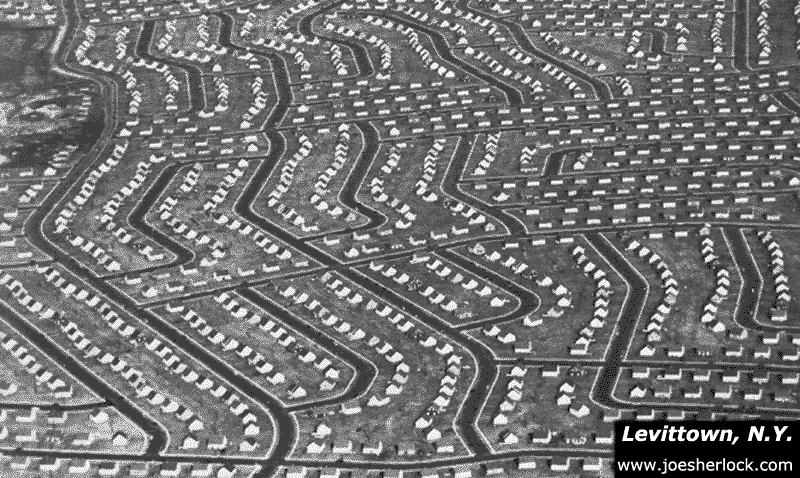
These new housing developments led to the middle-class migration to the suburbs and caused a demand for high-speed roads (turnpikes, expressways and freeways) to handle commuters driving their high-powered postwar cars at relatively high speeds into the city. In 1956, President Eisenhower signed the Federal-Aid Highway Act which gave birth to the Interstate Highway System.
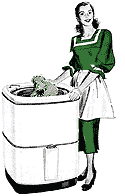 In 1947, Reddi-Whip was introduced to the American public. It was the first highly-artificial convenience food and could be sprayed out of a can, like paint or insect repellent. The accent was on convenience and speed, not taste. It was, perhaps, a first step toward the '50s trend of freeing the housewife from the drudgery of daily chores. In 1947, Reddi-Whip was introduced to the American public. It was the first highly-artificial convenience food and could be sprayed out of a can, like paint or insect repellent. The accent was on convenience and speed, not taste. It was, perhaps, a first step toward the '50s trend of freeing the housewife from the drudgery of daily chores.
The Fifties saw the mass production of labor-saving home appliances (4,196,000 electric clothes washers are sold in 1948 compared with 1,892,000 in 1941) and convenience foods to provide the fifties woman with more leisure time.
This 16-year period brought improvements in many aspects of everyday life. In 1948, 75% of all homes had flush toilets; this figure rose to over 90% by 1963. Only 64% of all '48 homes were had telephones; by 1963, 83% had phones. During this extended 16-year decade, the automobile fatality rate dropped by over 40%. The homicide rate dropped by 32%.
In 1948, only 33% of all adults had four years of high school education; by 1963, it had risen to 46%. (Today it's almost 80%.)
Our eating habits changed substantially during the 1950s. In 1948, Campbell's introduced V-8 Juice. The same year, the McDonald brothers opened their first fast-food stand - McDonald's, offering a limited menu or burgers and fries, prepared quickly and offered at a low price.
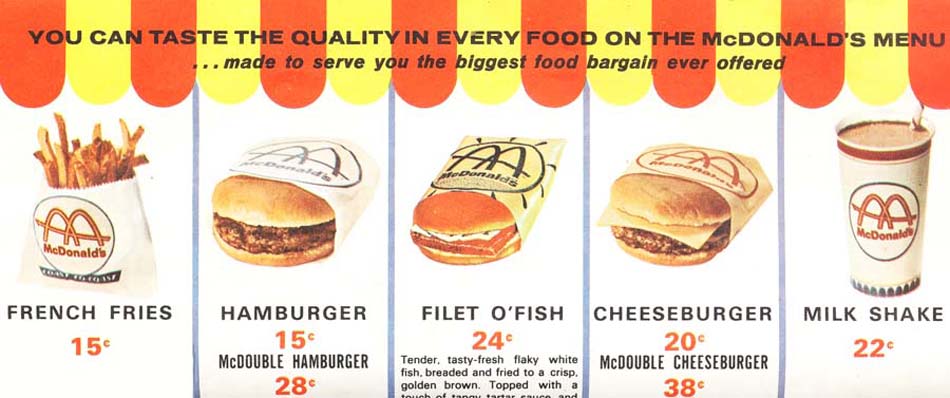
Drive-ins of all types proliferated - eat fast; dine in your car; zoom off. We wanted everything right away - including our food.
In 1948, Oreo, the best-selling cookie brand in the U.S., changed the name of its product to 'Oreo Crème Sandwich'. It was previously known as 'Oreo Biscuit' and 'Oreo Sandwich'. In 1949, prepackaged cake mixes were introduced as a 'convenience' food. In 1950, Minute Rice debuted. In 1951, a sugary breakfast cereal - Sugar Pops - was introduced. Within a year, Sugar Smacks and Sugar Frosted Flakes debuted to further address the nation's craving for sweets.
In 1951, Earl Tupper introduced Tupperware, making the preservation of leftovers a more convenient, time-saving task. In 1954, Swanson TV dinners debuted - frozen, assembly-line-prepared, mostly tasteless dinners in compartmentalized aluminum trays. Heat and eat. Quickly.
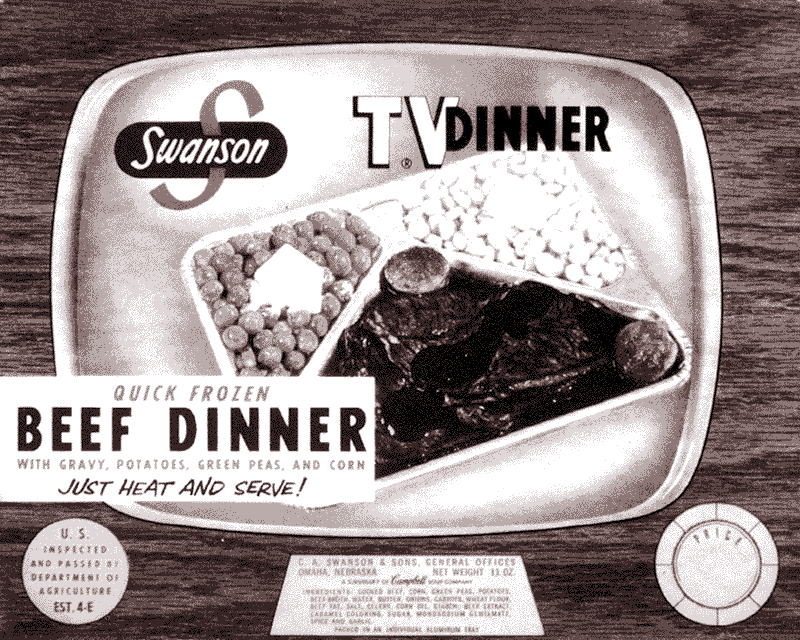
Tony the Tiger appeared in 1955 to promote Kellogg's Frosted Flakes cereal: "They're Grrrrreat!" By 1957, the average American family was consuming 850 cans of food each year. Sales of Mason jars and other labor-intensive canning and preserving supplies plummeted.
In 1960, Hawaiian Punch was introduced. It was sweet and non-carbonated - just punch open the can with a screwdriver and drink it up. Teflon-coated pots and pans for cooking convenience went on sale in December of 1960. Foods were now designed for convenience, speed and 'snack appeal.'
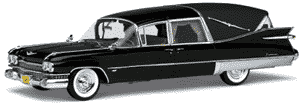 Cars changed dramatically in the postwar era. Those Cadillac tailfins continued to grow until they reached their zenith in the 1959 model year when they were almost as tall as the car itself. There were even fins on hearses of the era. Cars changed dramatically in the postwar era. Those Cadillac tailfins continued to grow until they reached their zenith in the 1959 model year when they were almost as tall as the car itself. There were even fins on hearses of the era.
Along the way, they started a trend - not just a trend toward fins, but a trend toward style-consciousness. Most cars of the Forties were dull. The styling was evolutionary and the color selection was limited. (To be fair, not much automotive design development went on during the first half of the 1940s; car manufacturers were too busy developing and producing tanks, planes and artillery for World War II.)

In the Fifties, there was a revolution in car design. In 1949, General Motors held its first Motorama, a giant car exposition exhibiting futuristic 'dream cars' and showing of all its brands with emphasis on style, power, convenience and features. And those four items were what '50s automobiles were all about. Other manufacturers quickly followed suit, offering lower, more stylish designs with additional horsepower.
In the Forties, returning servicemen were unhappy with automotive choices. New cars were scarce; old cars were worn out. Some of them bought old Thirties cars and rebuilt them, either hopping-up the engine to get better performance or customizing the car to make it look more modern. Or both. Competition soon ensued to see who had the fastest car or the wildest-looking car.
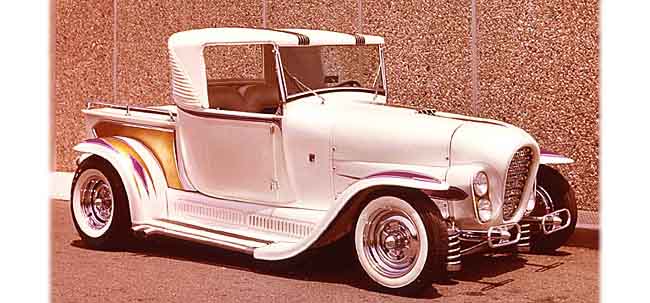
California customizer George Barris' Ala Kart show rod was based on a 1929 Ford Model A pick up truck. Construction of the custom rod began in 1957.
|
|

